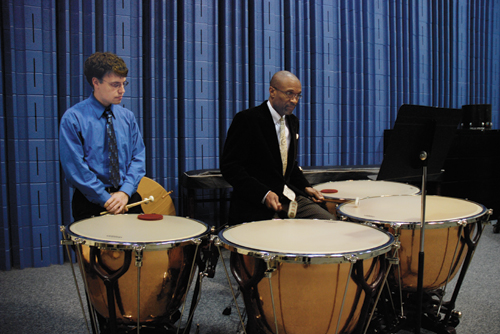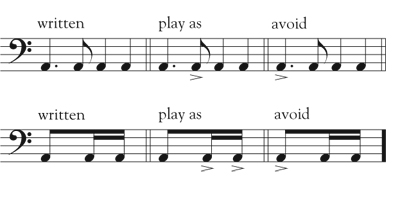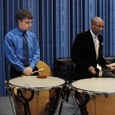
The three most important characteristics of timpani playing are always playing in tune, executing the part with impeccable rhythm, and producing a beautiful sound on the instrument at all times. The reason I have listed these concepts in this particular order is very simple. If the timpanist is out of tune, the timpanist’s contribution to the ensemble is absolutely unneeded. When the player is in tune and the rhythm is solid, then the timpanist can be a timekeeper and conductor from the rear. However, the timpanist who also plays with a beautiful tone along with the other two elements becomes a true artist. A timpanist with excellent tone can change the aesthetic of any ensemble from middle school band to professional orchestra.
Pitch and Tuning
Tuning the timpani initially should occur in a quiet environment if possible. This is typically not the norm so it is important for the timpanist to place an ear close to the head to hear the pitch carefully. The best pitch sources are a tuning fork, a piano, or a vibraphone. When students are learning how to tune, these three tools seem to produce the clearest pitch in my experience working with students – but make sure the piano has been tuned.
After playing the desired pitch on one of the three tuning tools, the timpanist should sing the pitch quietly and tap the timpani lightly in the playing spot with the pedal at the lowest position, which should sound the lowest pitch of that particular drum. After tapping the drum, slowly gliss the note up until it matches the desired pitch. If this does not work the first time, lower the pedal and start the process over. It is important for students to be patient when learning this valuable skill. During my first couple of lessons in college my teacher, Cloyd Duff, said to me, “It is not a sin to play out of tune but a sin to stay out of tune.” I have not forgotten this quote and I share it will all of my students during their first timpani lesson with me.
When playing in an ensemble, timpanists should be unafraid to make pitch adjustments if they feel the pitch does not match the ensemble. A great way to troubleshoot an intonation problem in an ensemble is first to play a little softer to make sure all of the other voices can be heard. This will help timpanists identify what direction to adjust intonation. It is important to continue to move the pedal slightly until the timpani matches the pitch of the group.
It is worth noting that an ensemble’s intonation typically rises at the end of pieces as the volume goes up. The timpanist should keep a foot on the pedal so this adjustment is made easily and smoothly. Various instruments in band and orchestras have sound and pitch tendencies based on the material the instruments are made of. Woodwind instruments that are made of wood tend to have a warm and low quality to their tone, which can be perceived as sounding flat. The timpanist must not be fooled by the round sound of these instruments. The same warning applies for the brass instruments. When these instruments play high in their range, they could be perceived as sounding sharp. These observations may seem overly generalized, but the aim is for timpanists to pay attention to the sounds around them in a more intimate way.
Timpani typically have eight tension rods that hold the head firmly onto the bowl. It is absolutely essential that each one of these rods sounds the same pitch. This allows the drum to produce a clear, centered pitch. If one rod is lower, then the head has a flat spot, meaning when the drum is hit loudly the pitch dips low briefly. The best way I have found to adjust a tension rod is to move it up a quarter turn to see if it improves the problem. Do not move a tension rod more than a quarter turn to avoid overcorrecting the problem and putting the drum out of tune the other direction.
Rhythm
The most important concept timpanists should grasp is that they are playing from the back of the ensemble. The sound has to travel at least 30 or more feet to reach the conductor and even farther to reach every part of the concert hall.
I avoid telling students to play on top of the beat, because students given that instruction often stop listening. Timpanists must play with the ensemble, and they just cannot be late. I like to tell timpanists to be aggressive, but this doesn’t mean loud. To me, aggressive playing is active, not lazy; it means being overly attentive to what the rhythm and sound are doing every second you play. It also means being primarily concerned with what the audience hears rather than what the timpanist hears. Aggressive is an attitude of concern that your notes get to the audience on time. Aggressive playing is assertive with a lot of energy. Play rhythms with commitment and a lot of integrity because the sound has to get to the front on time. Record the ensemble and play the recording for the timpanist, then evaluate where rhythms are and where they should be to sound on time in the group. It is essential that timpanists listen carefully to know who they are playing with and what their role is in the music at any given time.
One concept that works well in getting your rhythm from the back on time is to always pay close attention to the shortest notes of each rhythmic figure. For example: if the part has a dotted quarter note, then an eighth note, then two quarter notes, the eighth note is punctuated or brought out to make the rhythm move forward. The same would apply with one eighth and two sixteenth notes; bring out the sixteenth notes. This is especially important on the 29" and 32" drums.

Another element that contributes to clear rhythmic execution is mallet choice. A concept that works well is the faster the rhythm, the harder the stick. The slower the rhythm, the larger the stick. Young players tend to use big sticks when they see a passage that is loud. The problem with that stick choice is that it creates a lot of width but not a lot of volume. If the timpani is playing a rhythmic passage with the entire ensemble at a loud volume, a general stick works extremely well. If the timpani is playing a fast rhythmic passage alone, it is better to use a hard stick so the passage shoots clearly through the ensemble. I recommend that a school have a minimum of four pairs of timpani mallets: soft, general, staccato, and ultra staccato. Ultra staccato mallets are typically covered in billiard felt, and staccato mallets are covered with American felt hard side out. General mallets are covered with German felt soft side out or American felt soft side out, and soft mallets are covered with German Felt soft side out. These four pairs should get the timpanist through anything your ensemble will perform.
Great Sound
The sound description I give my students is quite simple: a timpanist’s job is to produce the sound of a 70-foot-tall string bass that is played by a 60-foot-tall bass player. Timpani should have a wonderful sustained sound that evokes that of a bass. You produce this sound on the timpani through rebound. When the timpanist lifts the stick off of the head at the moment of impact, he will produce a beautiful sound on the instrument. If the stick is not lifted off the head after the moment of impact, the tone can be distorted or unclear.
The key to producing a beautiful sound is to let the stick bounce naturally based on its velocity without letting it fall again after it rebounds. The lift off the drumhead should not be artificial or exaggerated; it is a natural movement that comes from the wrist. The player lets the stick bounce, then uses the hand and wrist to assist the stick in staying up. This is true regardless of the dynamic level or the number of notes played on the head. Young players rarely seem to realize the amount of sound that is needed to be heard in an ensemble, but it is still important to sound appropriate at all dynamic ranges. Lift the stick off of the head and pull the sound out of the instrument at all times.
A great timpani sound can also be achieved by timing. The timpani part is always heard in the context of what everyone else is playing. Whether the timpani part is melodic, textural, or supportive, a beautiful sound should always be the timpanist’s priority.
Students should not be fooled by the size of the timpani; it is possible to play the instrument with the same agility as a snare drum. Timpani playing should not have a slow, lethargic feel; it should sound light and elegant. The timpani is one of the most dramatic instruments in the percussion section. Students should spend as much time as they can discovering the endless possibilities of sound production on this wonderful instrument.





